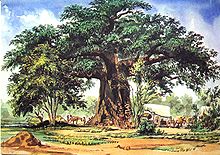Baobabs are wonderful trees. I love them! They store water, the leaves are nutritious for people and animals, they are the source of cream of tartar, and...well, they look as though they come from another planet. David Livingstone apparently said they looked like "a carrot planted upside down". I don't quite get that comparison, but in the winter - as in the specimen above - they certainly do look as though the roots are in the air. They're sometimes called upside-down trees.
The Bushmen have a number of legends about them. Great story tellers, it is hardly surprising that the baobab would intrigue and entertain them. One story is that in the beginning the gods distributed the seeds of all the plants to the animals to cultivate. The hyena was the last to receive his seed and it was a baobab. He was so disgusted to be last that he planted it upside down. An even more intriguing story is that baobabs don't grow at all. They are dropped from heaven fully grown, and being top heavy they land upside down with a loud thud still sometimes heard today...
The second legend may come from the fact that the trees are very slow growing indeed and the young ones look very different from the adults. Some of the adults are thousands of years old. They've seen a thing or two. Like ones with cannon balls embedded in their trunks from battles long past.
The largest may grow to 150 feet in circumference, and they can be used as shelters. Baobabs are not very common in Botswana - preferring the tropics - but in the north you see them from time to time. In Kasane, on the border with Zimbabwe, they were even once used as prisons - one for men and one for women. When the new police station was built, it was designed so that the trees and their history could be preserved.
Prison trees seemed to be an idea whose time had come. This one in Australia was used for a similar purpose.
 |
| This one does service as a pub. |
 |
Here's one on Kubu Island growing from the rocks. There aren't hippos on that dry pan despite the name!
This group in the northern Kalahari is known as 'the sleeping sisters', here in full leaf after unusually wonderful rains. The group is also named after Thomas Baines, naturalist, explorer and painter who seemed to have an affinity for these trees. He travelled with Livingstone, and also explored in Australia. Perhaps he was after the baobab species there. There the name is shortened (as with many names in Australia) to baobs.
 |
| Madagascar |
The family name is Adansonia and there are only eight species in the world. One is widely spread over Africa and Asia, one occurs in north-west Australia and the other six are in Madagascar. It's one of the many reasons that I'd love to visit there one day and see the forests of these amazing trees. The Madagascar species look quite different to ours; they have a sort of fantasy shape that makes you think they may have walked out of middle earth.

 They catch the eyes of editors too. Two of our books have them on the cover amid the African reds and oranges: A DEADLY TRADE (the UK edition of The Second Death of Goodluck Tinubu) and IL DETECTIVE KUBU (the Italian version of A Carrion Death). We love the menace of those eyes on the Italian book! (Cat eyes rather than hyena eyes, but then the baobabs are one of the species from Madagascar. No, we don't get to approve the covers!)
They catch the eyes of editors too. Two of our books have them on the cover amid the African reds and oranges: A DEADLY TRADE (the UK edition of The Second Death of Goodluck Tinubu) and IL DETECTIVE KUBU (the Italian version of A Carrion Death). We love the menace of those eyes on the Italian book! (Cat eyes rather than hyena eyes, but then the baobabs are one of the species from Madagascar. No, we don't get to approve the covers!) Michael - Thursday




















Gorgeous images, and they look stunning on those book covers.
ReplyDeleteI just moved to Mississippi, and am still mesmerized by the trees here. It's like they have stories inside.
It's wonderful to see pictures of the trees that are mentioned so often in books. This will probably be the only way, I'll see them. The Madagascar picture looks almost unreal. I don't have a title for your book; all I know is I look forward to it :)
ReplyDeletePerhaps you could use your influence to arrange for a recommission of sorts for one of those baobab prisons. Follow that up with stay by a certain cover artist or two, and I bet they'll never confuse their baobabs again.
ReplyDeleteThanks for the comments!
ReplyDeleteSurprisingly the prison trees are quite roomy inside and were good shelter (in those days). Whether the prisoners were treated decently is altogether a different question...
Michael.
baobabs are so interesting.I can't wait till your books to come out.
ReplyDeleteThe first 3 Detective Kubu books are available. A CARRION DEATH, THE SECOND DEATH OF GOODLUCK TINUBU (A DEADLY TRADE outside North America), and DEATH OF THE MANTIS. Hope you enjoy them.
ReplyDelete